
| Order | Index/Search | Home | About Us | Whats New |

|
|

|
Gregory Barsamian's three-dimensional animated sculptures probe some of the fundamental dilemmas of human existence while celebrating the potency of dreams. Employing the 19th-century theory of the persistence of vision, Barsamian creates kinetic sculptural pieces that meld and metamorphose familiar objects in unexpected ways to suggest cinematic alternative realities. Using rotating mechanical armatures and synchronized strobe lights, Barsamian's pieces transform simple animation into a boldly three-dimensional sculpture illusion --- one that is also a kind of magical realism. Barsamian's early work was based on simple mechanics: His Dipping Digits(1991) is a tabletop sculpture composed of a round, primordial form with sixteen sets of protruding arms and hands that dip into open but illegible books. As the hands literally scoop up the text, a lizard suddenly emerges from each book only to slip through the hands. Putti, another kinetic sculpture, questions the validity of human perception via the oddly disturbing phenomenon of flying cherubim that metamorphose into military helicopters and back again. This intriguing piece plays upon the tensions between opposites: love and war, beauty and austerity, imagination and reality. Barsamian's recent mechanistic works use a helix format to create more complex "stories" that emerge horizontally, vertically and diagonally. Such works, like Transfiguration and Two Step, draw on familiar elements from our collective past (a bird in flight, falling books, a torn photograph) to explore the repetition of human behaviors and the expressive and aggressive potential of human action. Like the mesmerizing Scream (1998), these pieces engage and horrify, fusing the mundane and the disturbing and confounding our senses like a wayward dream come to life. --Barbara Lee Williams, Leonardo/ISAST Awards Committee chairperson __________________________________________________ (artist questionnaire) Date of birth: April 18, 1953 Date and location of your first major exhibition: Behind the Iris, Bess Cutler Gallery, New York City, 1991 Location where you currently work (city and country): New York City since 1983 How do you see technology changing art for the good or ill in the next decade?: Technology is a tool. Since tools always leave a mark on their subject, artistic expression will show this mark. Difficult technologies tend to draw people away from the real reason to make art (to express things that you cannot express in any other way), to make art that is more about the technique. The beauty of recent technologies is that they keep getting easier to use, allowing people to focus more on the content...like a paintbrush that becomes an extension of the artist's hand. __________________________________________________ to learn more about Gregory Barsamian's work, visit this website http://www.concentric.net/~venial/ |